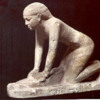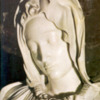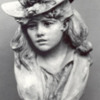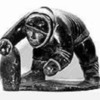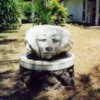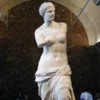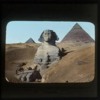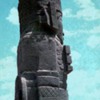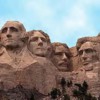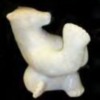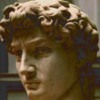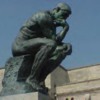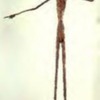http://artfaces.com/artkids/sculpture.htm
ARTAges- History of Sculpture
---
Sculpture, like other arts, is a record of human experience. From earliest times to our own day, sculpture records experiences that range from wars and worship to the simplest joys of seeing and touching suspended shapes designed to move in the wind. In sculpture there is everything from the marble gods of Phidias to the mobiles by Alexander Calder. People everywhere have found the need for sculpture, whether it be in work, in play, or in prayer. Sculpture also records the desire to commemorate the deeds of nations and of individuals.
---
UNDERSTANDING SCULPTURE
Tradition in Sculpture
Each period in art is a link in the golden chain of creative a achievement. If sculptors use historical examples and techniques to sharpen their vision, to deepen their insight, and to solve their problems, they use tradition creatively.
Lighting and Point of View
While working on a statue, the sculptor relies on proper light to study the planes by which masses turn from the light into the shade, creating the sense of solidity and third dimension. Only by light properly cast can he study shape, texture, and character.
The sculptor strives to show his finished work in the same light by which he worked originally. A light cast too weakly or too strongly from a source too high or too low can undo the effort of the sculptor and destroy the effectiveness of his creation.
Materials and Processes
To fashion sculpture man had to learn to use certain materials and to develop appropriate tools and processes. Carving is the process of reducing substances such as stone, wood, or ivory to a desired shape by cutting or chipping away unnecessary parts. The earliest carvings were probably nothing more than figures scratched into the flat surface of a rock. As time went on primitive sculptors discovered that by cutting away the background surrounding the figure, the animal or other figure appeared more real. This was the beginning of relief sculpture. Sculpture in which the figures extend from the background less than half of their natural volume is called low relief. That which extends beyond this point is called high relief, and sculpture that stands completely away from its background is said to be in full round.
Types of Casting
Casting is the process by which a piece of sculpture is reproduced through the use of a mold. A plaster mold consisting of two or more tightly fitting parts is made over or around the original clay model. When it is hard, the mold is removed, cleaned, oiled on the inside, and reassembled. Through an opening left for the purpose a creamy mixture of plaster and water is poured into the mold, and the mold is gently rolled so that the plaster is distributed evenly over the inner surface. The excess is poured out and the process is repeated until the desired thickness is achieved. When it is dry, this newly formed plaster shell is freed by chipping away the outer mold. The result is a perfect replica of the original model. Because the original clay model and the mold are both destroyed in the process, this is known as a waste mold.
The plaster cast can now be given a desired surface quality by paint or shellac or can be used as a model for further casting in more durable materials such as bronze and other metals, terra cotta, and cement. More complex molds, which permit more than one replica to be produced, must be used for this purpose. Thus it differs from the waste mold.
The casting of metals requires special skill and great care. Bronze has proved to be the most versatile metal for casting. The two principal methods are the sand mold process and the lost-wax (cire-perdue in French) process. The first uses a specially prepared sand mold, the second a silica mold.
Each mold has an inside core, built so as to leave a thin space between itself and the outer mold. The outer contour of this space bears the exact contour of the original cast from which the mold was made. When hot liquid bronze is poured into this space it takes the shape of the original plaster, thus resulting in a perfect reproduction. The space in the silica mold is filled with wax until it is melted out by the hot bronze, hence the name lost-wax process. This is the process made famous by Benvenuto Cellini and so skillfully practiced by many ancient peoples, especially the Chinese.
Patina
Patina is the term used for the surface color and quality of bronze and other materials. Without waiting for time, use, and atmospheric conditions to give a lovely surface to sculpture, artists use acids, heat, and other devices to achieve immediate effects of mellowness, age, and subtle color.
And now, having indicated an approach to the understanding of sculpture, we will undertake a brief survey of its history.
---
HISTORY
Sculpture Among Early Peoples
The earliest club wielded by the caveman was no great work of art, but it was sculpture of a kind. The gods that early peoples created out of their fear required a form as tangible as the club, though more complex. The earliest worshipers could not cope with abstract ideas of their gods. They had to see, touch, sacrifice to, and sometimes punish them.
In Polynesia and Peru, in southern France, New Zealand, Africa, and Mexico we find evidence that sculpture entered into every aspect of primitive life. Many of these early objects--whether intended for use or decoration--are fascinating in their strangeness and beautiful in their design. Modern artists, seeking new and vital forms of expression, have found a rich fountain of inspiration in these crude but serious efforts of early humans.
In the Americas sculpture thrived long before the arrival of Columbus. The Tarascans and Aztecs of ancient Mexico and the highly gifted Mayas of Central America rank high in pre-Columbian sculpture.
Among the most interesting finds in pre-Columbian sculpture are the archaeological remains near the town of Tula, Mexico--the ancient capital of the Toltecs. Among the structures were a palace complex, temple pyramids, a civic center, and a platform altar. Distinctively carved columns supported part of the main temple. Typical of these are the two sculptures pictured: warriors 15 feet tall and decorated with what may be ceremonial ornaments and dress of their time.
The Art of Egypt
As far back as 5,000 years ago Egypt had introduced a style that, with surprisingly little change, continued for almost 3,000 years. Rules for the making of statues were rigidly prescribed, as were social and religious customs. Religion was the dominant force in life on Earth and it required certain preparations for the life beyond. Sculpture was entirely associated with the needs of religion and the gods or with the earthly rulers who were regarded as their representatives (see Egypt, Ancient).
To symbolize the godlike role of the kings, they were represented as half human, half animal. The great Sphinx at Gizeh is the best-known example. To express their power and eternal life they were carved in the hardest stone and in colossal proportions. The statues of Rameses II at Abu Simbel are examples.
Woman Griding Grain
24th Century B.C. Egypt
Painted Limestone
Attachments
Original Post
